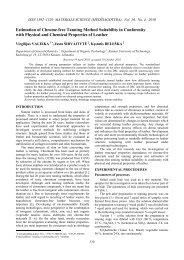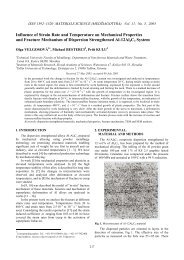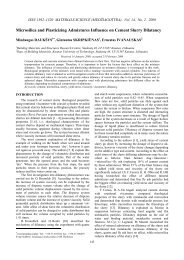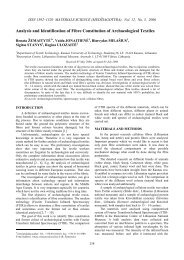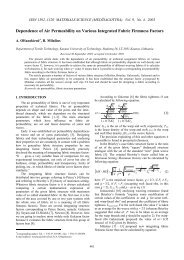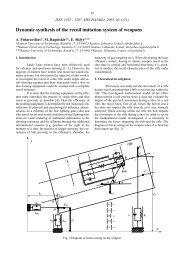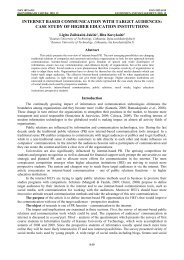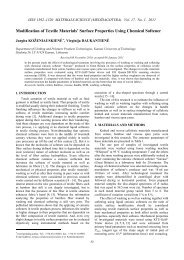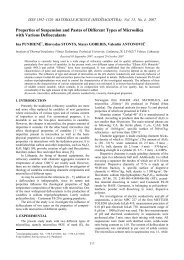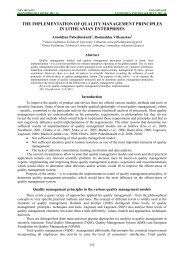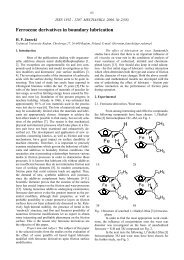1822-6515-2011-0014.pdf
1822-6515-2011-0014.pdf
1822-6515-2011-0014.pdf
You also want an ePaper? Increase the reach of your titles
YUMPU automatically turns print PDFs into web optimized ePapers that Google loves.
ISSN <strong>1822</strong>-<strong>6515</strong> ISSN <strong>1822</strong>-<strong>6515</strong><br />
EKONOMIKA IR VADYBA: <strong>2011</strong>. 16 ECONOMICS AND MANAGEMENT: <strong>2011</strong>. 16<br />
FAIR VALUE ACCOUNTING AND THE REGULATION OF CORPORATE<br />
REPORTING<br />
Carmen Giorgiana Bonaci 1 , Jiří Strouhal 2<br />
1 Babes-Bolyai University Cluj Napoca, Romania, carmen.bonaci@econ.ubbcluj.ro<br />
2 University of Economics Prague, Czech Republic, strouhal@vse.cz<br />
Abstract<br />
Our paper approaches fair value accounting and its implications when considering the regulation of<br />
financial reporting. Analyzing and discussing such issues is important for all parties being involved and/or<br />
interested in the debate over the regulation of corporate reporting. Economic realities and current<br />
developments have made many of us wonder about whether corporate reporting should be led by markets or<br />
by regulators. Meanwhile, the concept of fair value and its implementation takes us even further into an area<br />
where management’s input and disclosure takes on added significance. The objective of the paper is therefore<br />
to continue and help develop discussions on the highly debated topic of fair value accounting, enhancing the<br />
necessity of bringing together the efforts and inputs of accounting professionals, accounting researchers,<br />
regulators and company managers. The employed research methodology refers to the review of the academic<br />
literature on the analyzed topic.<br />
Keywords: Corporate reporting, fair value accounting, corporate governance, regulatory intervention.<br />
JEL Classification: M41, G30.<br />
Introduction<br />
The impact of fair value accounting is essential for all users of financial accounting information,<br />
especially when considering investment and financial decisions, therefore becoming the centre of attraction<br />
for a significant number of researchers and policy applications, including corporate governance. Since the<br />
use of fair value often involves estimates, this can also be considered as increasing managers’ discretion and<br />
further impact its implementation through reporting discretion issues. In terms of risk management, the aim<br />
and the standard setting challenge is to arrive at mandated disclosures that provide knowledgeable users of<br />
financial reports with a clear picture of the reporting enterprise’s risk exposures and how those risk<br />
exposures (and concentrations) are shifting over time (Schipper, 2005).<br />
While being extremely appealing from a conceptual point of view, when considering fair value’s<br />
implementation a series of difficulties have occurred in time. We must mention subjective, entity specific<br />
estimates of future cash flows that might even generate a lack of comparability. Ohlson et al. (2010) consider<br />
that subjective assumptions about risks, transactions costs, and the performance of counterparties are<br />
fundamentally inconsistent with acceptable accounting standards. Even more important is the fact that these<br />
approaches tend to degenerate into easy-to-manipulate versions of mark-to-market accounting, as proven by<br />
recent history. On the other hand some consider that the concept of fair value, but not historical cost,<br />
provides the common denominator necessary for a meaningful comparison of accounting data, while acting<br />
as a catalyst in a harmonization cycle (Barlev & Haddad, 2007). More precisely, it is argued that fair value<br />
accounting propels international accounting harmonization and international accounting harmonization<br />
provides more relevant information that may foster the efficiency of global markets, which improves the<br />
quality of the fair value accounting figures.<br />
IFRS adoption within the European Union inevitably brought a move towards more fair value<br />
accounting, being considered one of the most dramatic shifts in European accounting. On the other hand, the<br />
consequences of the financial crisis brought a series of interventions asking for regulatory change. Under<br />
these circumstances special attention is necessary in order not vastly alter the regulation of financial markets,<br />
including the regulation of accounting standard-setting (Bushman & Landsman, 2010). Another aspect that<br />
requires serious consideration refers to the relationship between financial accounting and prudential<br />
regulation, while having in mind the main objective of financial accounting information in enhancing<br />
corporate transparency that would benefit market discipline and capital allocation. In this regards, literature<br />
underlines the danger of subordinating financial accounting to the demands of prudential regulation of<br />
financial institutions as caring significant danger of unintended consequences (Bushman & Landsman,<br />
2010). In other words, the necessity of analyzing the role that corporate reporting plays in the regulation of<br />
financial institutions is emphasized within literature.<br />
14
ISSN <strong>1822</strong>-<strong>6515</strong> ISSN <strong>1822</strong>-<strong>6515</strong><br />
EKONOMIKA IR VADYBA: <strong>2011</strong>. 16 ECONOMICS AND MANAGEMENT: <strong>2011</strong>. 16<br />
Considering the above presented picture, fair value once again plays a central role, many considering<br />
that it exacerbated the crisis. The use of fair value for financial instruments received special attention in<br />
accounting research, some finding it documented outcomes motivated by some European governments' wish<br />
to see a solution that was consistent with their political goals rather than something which was actually in the<br />
public interest (Carsberg, 2010). A series of other current issues arising in the aftermath of the financial<br />
crisis, such as European Union's decision towards the acceptance of the International Financial Reporting<br />
Standard 9 and discussion in the US Congress to transfer oversight of accounting standards from the SEC to<br />
a systemic risk council charged with preserving the soundness of the banking system, for sure make us think<br />
twice about the impact crisis and scandals might have through regulatory intervention. This would be our<br />
main argument in developing an analysis that aims at offering a fair reflection of academic literature’s<br />
perception on fair value accounting, and its evolution in time, while considering different circumstances that<br />
might have impacted opinions being presented.<br />
We perform an analysis on the evolution of main considerations on fair value accounting as reflected<br />
through academic literature and focus on main conceptual underpinnings. Our analysis considers literature’s<br />
perception on such a debated concept which itself recorded an interesting evolution by rising despite a series<br />
of critiques and opponents to its application, therefore offering useful insights for the regulation of financial<br />
reporting.<br />
Research Methodology<br />
The analysis being developed in our paper relies on two main dimensions: accounting research<br />
literature on fair value and the accounting regulatory process. Accounting research literature on fair value is<br />
being analyzed by using literature review methodology, while focusing on study descriptions. The purpose of<br />
our focus is to help shape fair value debates that deal with fundamental implications for financial reporting.<br />
Due to the high number of studies dealing with fair value accounting, significant synthesis was necessary as<br />
well as strict selection criteria linked with the previously mentioned purpose of the study.<br />
The accounting regulatory process is only discussed in terms of its political implications due to the<br />
fact that fair value accounting was historically proven to be causing significant opportunities for those<br />
interested in transforming the accounting thing into a political thing (André et al., 2009). This also helped<br />
delimit our analysis when considering such a complex process.<br />
Accounting Research in Review<br />
If we are to review accounting research literature on fair value we must start with the 2008 issue of<br />
Abacus (Abacus, 44(2)) that reproduced papers from the September 2007 Siena Forum on Fair Value and the<br />
Conceptual Framework, covering the vexed question of fair value measurement (Dean, 2008), within the<br />
context of corresponding accounting regulatory initiatives, particularly the IASB and FASB’s efforts to<br />
develop a joint conceptual framework. McLeay (2008) synthesizes the main contributions brought through<br />
the papers being published within this special issue, as relevant and original approaches of the fair value<br />
concept. Whittington (2008) moulds IASB board members’ dissenting views into an overarching alternative<br />
to pure fair value accounting where financial reporting is based on entity specific measurements and is<br />
consistent with the stewardship requirements of current shareholders (McLeay, 2008). Discussant of<br />
Whittington’s paper, Bradbury (2008) argues in favour of fair value as the measurement objective, leaving<br />
open the choice of measurement methods (McLeay, 2008). Ronen (2008) also approaches fair value by<br />
considering the objectives of financial statements and the previously mentioned joint conceptual framework.<br />
He argues that the use of exit values in drawing financial statements should also impose presentation of<br />
information regarding cash flow expectations which would arise in case the entity’s resources continue to be<br />
used rather than sold, and of course regarding the realization of such expectations. Therefore, exist value<br />
accounting alone is considered to fail in adequately assessing the contribution made by managers to<br />
shareholder value (McLeay, 2008). As a discussant of Ronen’s paper, Turley (2008) questions the suitability<br />
of such proposals, which were design based on a context where investors’ interests are dominant, when<br />
considering other types of jurisdictions.<br />
Hitz (2007) develops a broad theoretical analysis of a fair value based reporting system focusing on<br />
the notion of decision usefulness, while evaluating the theoretical soundness of the arguments put forward<br />
by regulators and standard setting bodies. By considering the measurement or valuation perspective and the<br />
information perspective as approached to decision usefulness, his findings indicate that the decision<br />
15
ISSN <strong>1822</strong>-<strong>6515</strong> ISSN <strong>1822</strong>-<strong>6515</strong><br />
EKONOMIKA IR VADYBA: <strong>2011</strong>. 16 ECONOMICS AND MANAGEMENT: <strong>2011</strong>. 16<br />
relevance of fair value measurement can be justified from both perspectives, yet the conceptual case is not<br />
strong. A major aspect emphasized by Hitz’s (2007) findings was that standard setters need to clarify the<br />
notion of accounting income, its presumed contribution to decision relevance and its disaggregation, as a<br />
must for further implementation of fair value accounting. Landsman (2005) approaches issues that bank<br />
regulators need to consider if they are to use fair value accounting for determining bank regulatory capital<br />
and when making regulatory decisions. A significant aspect that he emphasized as requiring regulators’<br />
consideration questioned how to let managers reveal private information in their fair value estimates while<br />
minimizing strategic manipulation of model inputs to manage income and regulatory capital. Establishing<br />
how best to minimize measurement error in fair values so as to maximize their usefulness to investors and<br />
creditors as they make their investment decisions, and how best to ensure bank managers have incentives to<br />
select those investments that maximize economic efficiency of the banking system is considered equally<br />
important (Landsman, 2005).<br />
While fair value is mostly discussed in connection to financial instruments’ measurement, some<br />
studies also consider the use of fair value for non-financial items. An example in this regard would be<br />
Herrmann et al. (2006) who argue that fair value measures for property, plant, and equipment are superior to<br />
historical cost based on the characteristics of predictive value, feedback value, timeliness, neutrality,<br />
representational faithfulness, comparability, and consistency. This once again raises some conceptual<br />
implications in terms of the IASB/FASB joint conceptual framework since IFRSs are considered to be<br />
applying fair value more widely to non-financial assets than FASB standards do (Whittington, 2008).<br />
A very interesting approach to fair value accounting is that of Barlev & Haddad (2007) who analyze<br />
the concept within the broad context of international accounting harmonization. They present fair value as<br />
being suited to play the role of a common denominator that they consider necessary in order to complete our<br />
current understanding of international accounting harmonization systems. More precisely, they see this<br />
common denominator as helpful in measuring, recording and reporting business transactions, assets,<br />
liabilities and equities in a manner that would generate high quality comparability of accounting numbers.<br />
The idea of the common denominator clearly makes fair value accounting stand out in from of historical cost<br />
accounting, the first therefore offering feasibility to the idea of complete international accounting<br />
harmonization. Furthermore, since fair value accounting propels international accounting harmonization, the<br />
paradigm itself is seen as having the potential of acting as a catalyst in a harmonization cycle. International<br />
accounting harmonization is assumed to provide more relevant information which in turn should foster the<br />
efficiency of global markets and improve the quality of fair value accounting figures. The following figure<br />
synthesizes the idea of fair value accounting acting as a catalyst in a harmonization cycle:<br />
As previously mentioned, Barlev & Haddad (2007) analyze the paradigm of fair value accounting in<br />
relation to international accounting harmonization, therefore offering an original argument for an increased<br />
use of fair value measurements. Still, their paper relies on the assumption that a set of internationally<br />
implemented Generally Accepted Accounting Principles represents a must for a favorable process of<br />
16
ISSN <strong>1822</strong>-<strong>6515</strong> ISSN <strong>1822</strong>-<strong>6515</strong><br />
EKONOMIKA IR VADYBA: <strong>2011</strong>. 16 ECONOMICS AND MANAGEMENT: <strong>2011</strong>. 16<br />
international accounting harmonization. Furthermore they argue how the set must be completed with the<br />
required common denominator that would serve the accounting concept of comparability which also<br />
represents the core idea of international accounting harmonization. While accounting systems evolve, reflect<br />
and reinforce the economic environment they serve (Radebaugh et al., 1997 quoted by Barlev & Haddad,<br />
2007), the international accounting system is an outcome of the globalization of financial markets and the<br />
international economic integration (Iqbal et al., 1997; Epstein & Mirza, 2000 quoted by Barlev & Haddad,<br />
2007).<br />
Meanwhile, some opinions within accounting literature consider that international accounting<br />
standards optimised for stock market based capitalism are not necessarily optimal for other forms of<br />
capitalism and, since stock market capitalism has lost credibility as a way of doing business, the world<br />
may be better served by encouraging alternative forms of capitalism to develop with accounting standards<br />
tailored to their needs (Walker, 2010). We have all been witnessing how excessive credit expansion<br />
generated worldwide recession, recent events raising a series of question marks and doubts regarding<br />
financial reporting in general and financial accounting standards in particular. Under these circumstances<br />
there are fundamental reasons for resisting the call for a single set of global standards, starting with the<br />
idea that the right to set the accounting standard for the entire world would represent a very significant<br />
monopoly power (Walker, 2010). Therefore both of the core elements mentioned by Barlev & Haddad<br />
(2007) as required for a complete harmonization, namely a set of internationally implemented Generally<br />
Accepted Accounting Principles and fair value accounting, were brought into question due to the 2007-<br />
2009 financial crisis.<br />
Previous to the financial crisis, accounting researchers and especially fair value supporters were<br />
arguing that accounting standard setting bodies will continue to use fair value as the means of ensuring that<br />
transactions are represented faithfully in the financial statements (Cairns, 2006) and some even argued for<br />
the extension of the use of fair value measurements. Meanwhile a series of conceptual underpinnings, as the<br />
ones discussed above, continue to be debated within research literature, while studies on the value relevance<br />
of fair value also seem to be generating mixed results (Hann et al., 2007).<br />
But, as we know it, it is turbulent times that test any concept, lieder or even standard setting body,<br />
considering our discussions. Therefore Enron offered the right setting for Gwilliam & Jackson’s (2008)<br />
analysis on the use of mark to market accounting in financial reporting by means of a case study-based<br />
examination. Setting their results in the context of historical developments in and theoretical discussion upon<br />
asset valuation and income measurement, Gwilliam & Jackson (2008) emphasize the ease with which Enron<br />
was able to ‘monetize’ physical assets so as to bring them within the remit of mark to market accounting; the<br />
unreliability of valuation estimates provided by independent third parties; and the asymmetry between<br />
management desire to recognise mark to market gains through the income statement in contrast to their<br />
desire to avoid recognising mark to market losses.<br />
It is naturally that such finding as Gwilliam & Jackson’s (2008) have the tendency of advising<br />
standard setters think twice before encouraging further moves toward more widespread use of mark to<br />
market accounting. In line with such situations emphasizing shortcomings and difficulties of mark to market<br />
accounting we must also mention the recent market conditions of the credit crunch and reduced market<br />
liquidity which brought significant challenges for users, preparers and auditors of financial statements,<br />
especially in terms of measurement issues. Even if a significant number of studies (see Veron, 2008; André<br />
et al., 2009) defend the concept of fair value in the context of the financial crisis, documenting how fair<br />
value ended up by being either the scapegoat or the shot messenger, it was the turbulent times of 2007-2009<br />
that brought a series of shortcomings of the concept even more into the spotlight.<br />
Such a conceptual implication is disused by Schmidt (2009) through an observation that might be<br />
considered trivial on first glance. Schmidt (2009) discusses the notion of fair value based on its<br />
definition in both IFRSs and US GAAP, while considering both a perfect market and an imperfect<br />
market setting. He documents that when considering a scenario that is characterized by low liquidity<br />
and/or high information asymmetry, which is broadly consistent with the recent credit crunch, the IFRS<br />
definition of fair value is not readily applicable. The following figures reflect his discussions in the<br />
context of an imperfect market.<br />
17
ISSN <strong>1822</strong>-<strong>6515</strong> ISSN <strong>1822</strong>-<strong>6515</strong><br />
EKONOMIKA IR VADYBA: <strong>2011</strong>. 16 ECONOMICS AND MANAGEMENT: <strong>2011</strong>. 16<br />
Schmidt’s (2009) main reasoning is that in imperfect markets, buyer’s and seller’s marginal prices, at<br />
which they are rationally willing to transact, differ. On the other hand, the transaction price can be any<br />
amount within the range between those prices. Such a range is reflected in Figure 2. The problem appears<br />
for scenarios where no such range exists because the seller’s marginal price exceeds the buyer’s, as reflected<br />
in Figure 3.<br />
The Accounting Standard Setting’s Perspective and Political Implications<br />
A significant issue that is also emphasized through accounting research literature and whose importance<br />
was enhanced due to current turbulent times relates to having directly linked prudential requirements for equity<br />
capital to accounting rules. More precisely, this led to the banking sector arguing fair value’s pro-cyclical effect<br />
under crisis circumstances. In order to maintain their regulatory capital, financial institutions had to sell assets,<br />
therefore only enhancing the downward trend of the markets. This of course only generated further need to sell,<br />
therefore completing the pro-cyclical effect. This situation confronted us with a major dilemma: What is it that<br />
should be changed? The accounting model or the way regulators establish the required level of equity capital?<br />
Or maybe both? It is still for sure that we must therefore acknowledge the fundamental inconsistency between<br />
accounting measurement and prudential valuation (André et al., 2009). What mostly differentiate the two are<br />
precisely their objectives: while the first aims for financial-accounting information that is useful to stakeholders<br />
and particularly relevant to investors’ needs (Matherat, 2008 quoted by André et al., 2009), the latter ought to<br />
aim prudence from the regulator’s point of view.<br />
For sure we remember an extremely interesting situation that rose in the context of EU adopting IFRSs<br />
for consolidated financial statements of listed companies, starting with year 2005, through the so-called EU<br />
IAS Regulation (1606/2002). More precisely we refer to the European, especially French banks’ well-known<br />
opposition to carrying financial instruments at fair value. Furthermore, it was in 2003 that they actually<br />
convinced the then French president, Jacques Chirac, to write to the EC and complain that this would<br />
18
ISSN <strong>1822</strong>-<strong>6515</strong> ISSN <strong>1822</strong>-<strong>6515</strong><br />
EKONOMIKA IR VADYBA: <strong>2011</strong>. 16 ECONOMICS AND MANAGEMENT: <strong>2011</strong>. 16<br />
destabilise the economy. After many months of negotiations, the compromise was reached through what we<br />
know as the IAS 39 carves out. This of course had direct impact on IASB and brought threats of carve outs<br />
elsewhere, but until nowadays IASB has only accepted the original carve out. Still, it was once again the<br />
2007-2009 financial crisis that nearly brought another carve out, once again required by EU and once again<br />
related to fair value of some financial instruments. This time it was based on the EU IAS Regulation that EU<br />
almost went for another carve out. The Regulation includes a requirement that IFRS endorsed by EU must<br />
not disadvantage European companies when compared with those in other major markets. This time it was<br />
President Nicolas Sarkozy that had to deal with French banks lobbying who were worried not to be<br />
disadvantaged in comparison with American banks. It was then found that an old US standard did not require<br />
property mortgages to be held at fair value and that SFAS 133 allowed available for sale financial<br />
instruments to be re-classified under rare circumstances. Since IAS 39 included a key anti-abuse requirement<br />
based on which entities determined at inception into which category each financial asset fell, without<br />
acceptance of subsequent re-classification, the reason was found to argue for another potential carve out. A<br />
compromise was found in October 13, 2008 through the amendment to IAS 39 for reclassifications of<br />
financial assets, allowing certain re-classifications (for more details see André et al., 2009).<br />
The risk of taking away all safeguards on manipulating the categories of financial instruments<br />
(referring to the possibility of transferring all loss making assets to amortised cost and profit making assets to<br />
fair value through profit and loss) was controlled. Unfortunately we cannot say the same thing about IASB’s<br />
credibility.<br />
Conclusions<br />
As Veron (2008) pointed out, a vigorous debate about fair value was made necessary by the recent<br />
financial disruption, which provides a real-world litmus test of accounting standards. As previously<br />
discussed, the standard setting process itself and standard setting bodies have been questioned and closely<br />
analyzed as a consequence of recent events that marked our history. The interesting times we are living<br />
clearly point to an extensive new agenda for predictive international accounting research (McLeay, 2008).<br />
The regulatory competition and the worldwide globalisation project were also for sure influenced by the<br />
circumstances and outcomes of the credit crunch, as even the new SEC chairperson, Mary Schapiro said that<br />
she thought a single set of global standards would be a very beneficial thing, but expressed doubts about the<br />
independence of IASB and declared she would not necessarily be bound by the proposed roadmap (World<br />
Accounting Report, February 2009 quoted by André et al., 2009).<br />
The concepts of fair value and fair value accounting for sure have their shortcomings and opponents<br />
that were even more encouraged through recent events, but we consider the most appropriate manner to<br />
handle the situation is to give it a fair trial. We consider initiatives such as that of Abacus special issue which<br />
we discussed to be useful in shifting the fair value debate towards greater recognition of the fundamental<br />
implications for institutions and markets (McLeay, 2008). As Bradbury (2008) concludes, it is possible that<br />
replacement cost is a better measurement method on some dimensions; deprival value is better on other<br />
dimensions; and even historical cost is better on certain dimensions; as well as it is still possible for fair<br />
value accounting to be, on average, the best. Being on the same page with André et al., (2009) who see fair<br />
value as the messenger being shot for the crisis, Veron (2008) considers it to be the financial accounting<br />
thermometer which would not help in improving the health of the patient if broken and tweaked, but would<br />
only make the doctors’ task that bit harder.<br />
Political implications that inevitably arise in the international accounting arena, as documented<br />
through our paper, should also be considered and dealt with, so that they don’t interfere with designing and<br />
implementing an adequate conceptual framework and accounting standards that aim for the quality of<br />
financial reports. Issues such as the measurement attribute of financial instruments being dictated through the<br />
four categories in IAS 39 used to be debated even before the crisis, but having the crisis as an excuse for<br />
their manipulation is not justified either. Meanwhile we will have to further debate these aspects with<br />
reference to the new IFRS 9 Financial Instruments, covering classification and measurement of financial<br />
assets, as the first part of IASB’s project to replace IAS 39.<br />
Acknowledgment<br />
This paper is part of the research project POSDRU/89/1.5/S/59184 ‘Performance and excellence in<br />
postdoctoral research within the field of economic sciences in Romania’, Babeş-Bolyai University, Cluj-<br />
19
ISSN <strong>1822</strong>-<strong>6515</strong> ISSN <strong>1822</strong>-<strong>6515</strong><br />
EKONOMIKA IR VADYBA: <strong>2011</strong>. 16 ECONOMICS AND MANAGEMENT: <strong>2011</strong>. 16<br />
Napoca being a partner within the project and project GA403/11/0002 registered at Czech Science<br />
Foundation (GA ČR).<br />
References<br />
1. André, P., Cazavan-Jeny, A., Dick, W., Richard, C. & Walton, O. (2009). Fair Value Accounting and the Banking<br />
Crisis in 2008: Shooting the Messenger. Accounting in Europe, 6(1-2), 3-24.<br />
2. Barlev, B., & Haddad, J.R. (2007). Harmonization, Comparability and Fair Value Accounting. Journal of<br />
Accounting, Auditing & Finance, 22(3), 493-509.<br />
3. Bradbury, M. (2008). Discussion of Whittington. Abacus, 44(2), 169-180.<br />
4. Bushman, R., & Landsman, W.R. (2010). The pros and cons of regulating corporate reporting: a critical review of<br />
the arguments. Accounting and Business Research, 40(3), 259-273.<br />
5. Cairns, D. (2006). The Use of Fair Value in IFRS. Accounting in Europe, 3, 5-22.<br />
6. Carsberg, B. (2010). Discussion of “The political economy of regulation: does it have any lessons for accounting<br />
research?”. Accounting and Business Research, 40(3), 227-228.<br />
7. Dean, G. (2008). Inaugural Abacus Manuscript Award Winner and the Abacus Forum on Fair Value and the<br />
Conceptual Framework, Editorial. Abacus, 44(2), i-viii<br />
8. Epstein, B.J., & Mirza, B.B. (2000). IAS–Interpretation and Application of International Accounting Standards<br />
2000. New York, NY: John Wiley & Sons, Inc.<br />
9. Gwilliam, D. & Jackson, R.H.G. (2008). Fair value in financial reporting: Problems and pitfalls in practice A case<br />
study analysis of the use of fair valuation at Enron. Accounting Forum, 32, 240-259<br />
10. Hann, R.N., Heflin, F., & Subramanayam, K.R. (2007). Fair-value pension accounting. Journal of Accounting and<br />
Economics, 44, 328-258.<br />
11. Herrmann, D., Saudagaran, S.M. & Thomas, W.B. (2006). The quality of fair value measures for property, plant<br />
and equipment. Accounting Forum, 30, 43-59.<br />
12. Hitz, J.M. (2007). The Decision Usefulness of Fair Value Accounting - A Theoretical Perspective. European<br />
Accounting Review, 16(2), 323-362.<br />
13. Iqbal, M.Z., Melcher, T.U., & Elmallah, A.A. (1997). International Accounting—A Global Perspective. Mason,<br />
OH: South-Western College Publishing.<br />
14. Landsman, W.R. (2005). Fair Value Accounting for Financial Instruments: Some Implications for Bank<br />
Regulation. Paper presented at the Workshop on Accounting Risk Management and Prudential Regulation, Bank of<br />
International Settlement, Basel, Switzerland, November 11-12, 2005, 1-27.<br />
15. Matherat, S. (2008). Juste valeur et stabilité financière: enjeux de marché et dynamiques stratégiques in Banque de<br />
France. Revue de la stabilité financière, 12, 61-72.<br />
16. McLeay, S. (2008). Forum Guest Editorial. Abacus, 44(2), 137-138.<br />
17. Ohlson, J.A., Penman, S., Bloomfield, R., Christensen, T.E., Colson, R., Jamal, K., Moehrle, S., Previts, G., Stober,<br />
T., Sunder, S., & Watts, R.L., (2010), A Framework for Financial Reporting Standards: Issues and a Suggested<br />
Model. Accounting Horizons, 24(3), 471-185.<br />
18. Radebaugh, L., Gray, H., & Sidney, J., (1997). International Accounting and Multinational Enterprises. Canada:<br />
John Wiley and Sons, Inc.<br />
19. Ronen, J. (2008). To Fair Value or Not to Fair Value: A Broader Perspective. Abacus, 44(2), 181-208.<br />
20. Schipper, K. (2005). The Introduction of International Accounting Standards in Europe: Implications for<br />
International Convergence. European Accounting Review, 14(1), 101-126.<br />
21. Schmidt, M. (2009). Fair Value: Your Value or Mine? An Observation on the Ambiguity of the Fair Value Notion<br />
Illustrated by the Credit Crunch, Accounting in Europe, 6(1-2), 271-282.<br />
22. Turley, S. (2008). Discussion of Ronen. Abacus, 44(2), 209-216.<br />
23. Veron, N. (2008), Fair Value Accounting is the Wrong Scapegoat for this Crisis. Accounting in Europe, 5(2), 63-<br />
69.<br />
24. Walker, M. (2010). Accounting for varieties of capitalism: The case against a single set of global accounting<br />
standards. The British Accounting Review, 42, 137-152.<br />
25. Whittington, G. (2008). Fair Value and the IASB/FASB Conceptual Framework Project: An Alternative View.<br />
Abacus, 44(2), 139-168.<br />
20



